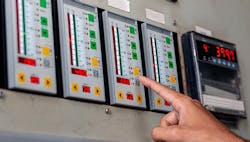Technology is advancing component design faster than ever, and variable frequency drive design is heavily influenced in the current market by concerns for safety, energy management and design flexibility. What will the future hold? Six manufacturers—SEW Eurodrive, ABB, Siemens, Bosch Rexroth, Hitachi Industrial Equipment & Solutions and Schneider Electric—give their predictions for what’s in store for VFDs. For more on current market trends for VFDs, read “Flexible design brings VFDs to wider market.”
1. Field mountable, modular solution: “As we start to minimize the size of our electronics and increase the efficiency of our motors, I see VDFs being part of a field-mountable, compact, modular and configurable drive, I/O and control solution,” says Leo Young, business development manager, drive and automation, at SEW Eurodrive. “This solution would be installed in a field-mountable modular enclosure and provide configurable options for control, drive inverters, motors and gearboxes. The modular concept would also provide network connectivity to common bus systems, integrated safety and options for energy management, such as capture and use of regenerative energy. I would see different levels of control offered in a modular platform—the first being a centralized control unit with embedded machine control functionality, drive control and I/O, which can be networked to other drive modules for expansion; the second unit being a decentralized control module, including embedded motion control for a limited group of drives and I/O, which can be networked back to a host controller; the third being a mechatronic package with integrated drive, motor, gearbox and I/O with an option for single axis embedded control functions. These units can be configured for decentralized control of the drives and I/O in a single modular unit or can be networked with other drive units for a centralized control architecture. This type of unit could replace an entire inverter control cabinet and support machine modularity.”
2. Smarter VFD software: “There will be continued focus on providing application software that is located on the VFD itself,” says David Orlikowski, LV drives regional engineer at ABB. “This will allow end users to have more efficient process control and achieve maximum energy savings in unique and challenging applications across industries, such as chemical, oil and gas, water and HVAC.”
For OEMs, steep learning curves are a drawback. “Having to learn new interfaces and programming for each VFD, even when they use the same vendor, increases their time to market,” explains Orlikowski. “Vendors who provide VFDs with consistent user interfaces across the entire platform will be important. Having more application expertise built into the VFD will also be important. All of this will help to reduce development time and cost and enable them to move on to the next project quickly.”
3. New applications and industries: “VFDs are not motor shaft turners anymore,” says Navid Binesh, senior technical consultant at Siemens. “They are being applied to many new applications. Applications with grid interface, such as frequency converters and pump storage, use VFDs. New industries such as carbon capture and hydrogen generation and transportation rely on VFDs. The power requirements are growing to beyond 50,000 hp.”
4. More application specific programming: “The future of variable-frequency-drive design and customer applications is software integration and specific application programming. Data access must be easily accessible to share and connect seamlessly,” says Joaquin Ocampo, product manager for automation and electrification at Bosch Rexroth.
5. Plug-and-play programming: “We expect drives that can do more, such as logic-based operation, and plug-and-play via QR code programming, and also constant-torque, permanent-magnet, alternating current (PMAC) applications where the energy savings are substantial,” says Robert Pauley, sales manager, ac drives division, at Hitachi.
6. ML and AI for better control: “In the longer term, machine learning (ML) and artificial intelligence (AI) will play a greater factor,” says David Chen, senior offer manager at Schneider Electric. “Most of the VFD commissioning process is repetitive, and the difficulties around commissioning are based on a lack of product knowledge or understanding of the application. Once application databases are built, the utilization of machine learning into VFDs reduces this. Artificial intelligence will also support system optimization as it will allow for smart reactions under a controlled industrial environment to benefit the process.”
For more on IIoT trends and challenges for the VFD market, read “5 ways IIoT/Industry 4.0 is changing VFD design” and “Tall order: 4 market challenges for VFDs.”
About the Author
Anna Townshend
Managing Editor
Anna Townshend has been a writer and journalist for 20 years. Previously, she was the editor of Marina Dock Age and International Dredging Review, until she joined Endeavor Business Media in June 2020. She is the managing editor of Control Design and Plant Services.

Leaders relevant to this article:


